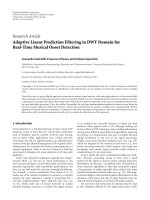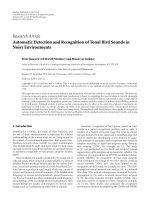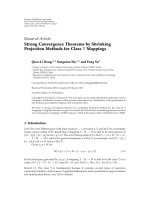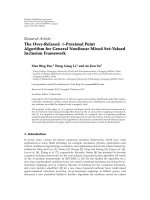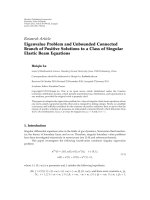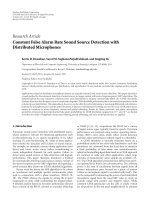báo cáo hóa học:" Research Article Data Cache-Energy and Throughput Models: Design Exploration for Embedded Processors" doc
Bạn đang xem bản rút gọn của tài liệu. Xem và tải ngay bản đầy đủ của tài liệu tại đây (673.78 KB, 7 trang )
Hindawi Publishing Corporation
EURASIP Journal on Embedded Systems
Volume 2009, Article ID 725438, 7 pages
doi:10.1155/2009/725438
Research Article
Data Cache-Energy and Throughput Models: Design Exploration
for Embedded Processors
Muhammad Yasir Qadri and Klaus D. McDonald-Maier
School of Computer Science and Electronic Engineering, University of Essex, Colchester CO4 3SQ, UK
Correspondence should be addressed to Muhammad Yasir Qadri,
Received 25 March 2009; Revised 19 June 2009; Accepted 15 October 2009
Recommended by Bertrand Granado
Most modern 16-bit and 32-bit embedded processors contain cache memories to further increase instruction throughput of the
device. Embedded processors that contain cache memories open an opportunity for the low-power research community to model
the impact of cache energy consumption and throughput gains. For optimal cache memory configuration mathematical models
have been proposed in the past. Most of these models are complex enough to be adapted for modern applications like run-time
cache reconfiguration. This paper improves and validates previously proposed energy and throughput models for a data cache,
which could be used for overhead analysis for various cache types with relatively small amount of inputs. These models analyze
the energy and throughput of a data cache on an application basis, thus providing the hardware and software designer with the
feedback vital to tune the cache or application for a given energy budget. The models are suitable for use at design time in the
cache optimization process for embedded processors considering time and energy overhead or could be employed at runtime for
reconfigurable architectures.
Copyright © 2009 M. Y. Qadri and K. D. McDonald-Maier. This is an open access article distributed under the Creative Commons
Attribution License, which permits unrestricted use, distribution, and reproduction in any medium, provided the original work is
properly cited.
1. Introduction
The popularity of embedded processors could be judged by
the fact that more than 10 billion embedded processors were
shipped in 2008, and this is expected to reach 10.76 billion
units in 2009 [1]. In the embedded market the number of
32-bit processors shipped has surpassed significantly that of
8-bit processors [2]. Modern 16-bit and 32-bit embedded
processors increasingly contain cache memories to further
instruction throughput and performance of the device. The
recent drive towards low-power processing has challenged
the designers and researchers to optimize every component
of the processor. However optimization for energy usually
comes with some sacrifice on throughput, and which may
result in overall minor gain.
Figure 1 shows the operation of a typical battery powered
embedded system. Normally, in such devices, the processor
is placed in active mode only when required; otherwise it
remains in a sleep mode. An overall power saving (increased
throughput to energy ratio) could be achieved by increasing
the throughput (i.e., lowering the duty cycle), decreasing
the peak energy consumption, or by lowering the sleep
mode energy consumption. This phenomenon clearly shows
the interdependence of energy and throughput for overall
power saving. Keeping this in mind, a simplified approach
is proposed that is based on energy and throughput models
to analyze the impact of a cache structure in an embedded
processor per application basis which exemplifies the use
of the models for design space exploration and software
optimization.
The remainder of this paper is divided into five sections.
In the following two sections related work is discussed and
the energy and throughput models are introduced. In the
fourth section experimental environment and results are
discussed, the fifth section describes an example application
for the mathematical models, and the final section forms the
conclusion.
2. Related Work
The cache energy consumption and throughput models
have been the focus of research for some time. Shiue and
2 EURASIP Journal on Embedded Systems
Power consumption
Time
Active mode power
Average power
Sleep mode power
Figure 1: Power consumption of a typical battery powered
processor (adapted from [3]).
Chakrabarti [4] present an algorithm to find optimum
cache configuration based on cache size, the number of
processor cycles, and the energy consumption. Their work
is an extension of the work of Panda et al. [5, 6]ondata
cache sizing and memory exploration. The energy model by
Shiue and Chakrabarti , though highly accurate, requires a
wide range of inputs like number of bit switches on address
bus per instruction, number of bit switches on data bus per
instruction, number of memory cells in a word line and in
a bit line, and so forth. which may not be known to the
model user in advance. Another example of a detailed cache
energy model was presented by Kamble and Ghose [7]. These
analytical models for conventional caches were found to be
accurate to within 2% error. However, they over-predict the
power dissipations of low-power caches by as much as 30%.
The low-power cache designs used by Kamble and Ghose
incorporated block buffering, data RAM subbanking, and
bus invert coding for evaluating the models. The relative
error in the models increased greatly when the sub-banking
and block buffering were simultaneously applied. The major
difference between the approach used by Kamble and Ghose
[7] and the one discussed in this paper is that the former
one incorporated bit level models to evaluate the energy
consumption, which are in some cases inaccurate as the error
in output address power was found (by the Kamble and
Ghose ) in the order of 200%, due to the fact that data
and instruction access addresses exhibit strong locality. The
approach presented here uses a standard cache modelling
tool, CACTI [8], for measuring bit level power consumption
in cache structures and provides a holistic approach for
energy and throughput for an application basis. In fact the
accuracy of these models is independent of any particular
cache configuration as standard cache energy and timing
tools are used to provide cache specific data. This approach
is discussed in detail in Section 4.
Simunic et al. [9] presented mathematical models for
energy estimation in embedded systems. The per cycle energy
model presented in their work comprises energy components
of processor, memory, interconnects and pins, DC-to-DC
converters, and level two (L2) cache. The model was
validated using an ARM simulator [10] and the SmartBadge
[11] prototype based on ARM-1100 processor. This was
found to be within 5% of the hardware measurements for
the same operating frequency. The models presented in
their work holistically analyze the embedded system power
and do not estimate energy consumption for individual
components of a processor that is, level one (L1) cache, on-
chip memory, pipeline, and so forth. In work by Li and
Henkel [12] a full system detailed energy model comprising
cache, main memory, and software energy components was
presented. Their work includes description of a framework to
assess and optimize energy dissipation of embedded systems.
Tiwari et al. [13] presented an instruction level energy model
estimating energy consumed in individual pipeline stages.
The same methodology was applied in [14] by the authors
to observe the effects of cache enabling and disabling.
Wada et al. [15] presented comprehensive circuit level
access time model for on-chip cache memory. On comparing
with SPICE results the model gives 20% error for an 8
nanoseconds access time cache memory. Taha and Wills [16]
presented an instruction throughput model for Superscalar
processors. The main parameters of the model are super-
scalar width of the processor, pipeline depth, instruction
fetch method, branch predictor, cache size and latency, and
so forth. The model results in errors up to 5.5% as compared
to the SimpleScalar out-of-order simulator [17]. CACTI
(cache access and cycle time model) [8] is an open-source
modelling tool based on such detailed models to provide
thorough, near accurate memory access time and energy
estimates. However it is not a trace driven simulator, and so
energy consumption resulting in number of hits or misses is
not accounted for a particular application.
Apart from the mathematical models, substantial work
has been done for cache miss rate prediction and minimiza-
tion. Ding and Zhong in [18] have presented a framework for
data locality prediction, which can be used to profile a code
to reduce miss rate. The framework is based on approximate
analysis of reuse distance, pattern recognition, and distance-
based sampling. Their results show an average of 94% accu-
racy when tested on a number of integer and floating point
programs from SPEC and other benchmark suites. Extending
their work Zhong et al. in [19] introduce an interactive
visualization tool that uses a three-dimensional plot to show
miss rate changes across program data sizes and cache sizes.
Another very useful tool named RDVIS as a further extension
of the work previously stated was presented by Beyls et al.
in [20, 21]. Based on cluster analysis of basic block vectors,
the tool gives hints on particular code segments for further
optimization. This in effect provides valuable feedback to
the programmer to improve temporal locality of the data to
increase hit rate for a cache configuration.
The following section presents the proposed cache energy
and throughput models, which can be used to identify an
early cache overhead estimate based on a limited set of input
data. These models are an extension of the models previously
proposed by Qadri and Maier in [22, 23].
3. The D-Cache Energy and Throughput Models
The cache energy and throughput models given below strive
to provide a complete application-based analysis. As a result
they could facilitate the tuning of a cache and an application
EURASIP Journal on Embedded Systems 3
Table 1: Simulation platform parameters.
Parameter Value
Processor PowerPC440GP
Execution mode Turbo
Clock frequency (Hz) 1.00E+08
Time 1.00E
−08
CPI 1
Technology 0.18 um
Vdc (V) 1.8
Logic Supply (V) 3.3
DDR SDRAM (V) 2.5
VDD (1.8 V) active
operating current
IDD (A)
9.15E
−01
OVDD (3.3 V) active
operating current
IODD (A)
1.25E
−01
Energy per Cycle (J) 1.65E
−08
Idle mode Energy (J) 4.12E
−09
Table 2: Cache simulator data.
CACTI Data
Cache Size 32 Kbytes
Block Size 256 bytes
R/W Ports 0
Read ports 1
Write ports 1
Access Time (s) 1.44E
−09
Cycle Time (s) 7.38E
−10
Read Energy (J) 2.24E
−10
Write Energy (J) 3.89E
−11
Leakage Read Power (W) 2.96E
−04
Leakage Write Power (W) 2.82E
−04
according to a given power budget. The models presented
in this paper are an improved extension of energy and
throughput models for a data cache, previously presented
by the authors in [22, 23]. The major improvements in the
model are as follows: (1) The leakage energy (E
leak
)isnow
indicated for the entire processor rather than simply the
cache on its own. The energy model covers the per cycle
energy consumption of the processor. The leakage energy
statistics of the processor in the data sheet covers the cache
and all peripherals of the chip. (2) The miss rate in E
read
and
E
write
has been changed to read
mr
(read miss rate) and write
mr
(write miss rate) as compared to total miss rate (r
miss
) that
was employed previously. This was done as the read energy
and write energy components correspond to the respective
miss rate contribution of the cache. (3) In the throughput
model stated in [23]atermt
mem
(time saved from memory
operations) was subtracted from the total throughput of the
system, which was later found to be inaccurate. The overall
time taken to execute an instruction denoted as T
total
is the
measure of the total time taken by the processor for running
an application using cache. The time saved from memory
only operations is already accounted in T
total
.Howeveranew
term t
ins
was introduced to incorporate the time taken for the
execution of cache access instructions.
3.1. Energy Model. If E
read
and E
write
are the energy con-
sumed by cache read and write accesses, E
leak
the leakage
energy of the processor, E
c → m
the energy consumed by
cache to memory accesses, E
mp
the energy miss penalty,
and E
misc
is the Energy consumed by the instructions which
do not require data memory access, then the total energy
consumption of the code E
total
in Joules (J) could be defined
as
E
total
= E
read
+ E
write
+ E
c → m
+ E
mp
+ E
leak
+ E
misc
. (1)
Further defining the individual components,
E
read
= n
read
· E
dyn.read
·
1+
read
mr
100
,
E
write
= n
write
· E
dyn.write
·
1+
write
mr
100
,
E
c → m
= E
m
·
(
n
read
+ n
write
)
·
1+
total
mr
100
,
E
mp
= E
idle
·
(
n
read
+ n
write
)
·
P
miss
·
total
mr
100
,
(2)
where n
read
is the number of read accesses, n
write
the number
of write accesses, E
dyn.read
the total dynamic read energy for
all banks, E
dyn.write
the total dynamic write energy for all
banks, E
m
the energy consumed per memory access, E
idle
the
per cycle idle mode energy consumption of the processor,
read
mr
,write
mr
, and total
mr
are the read, write, and total
miss ratio (in percentage), and P
miss
is the miss penalty (in
number of stall cycles).
The idle mode leakage energy of the processor E
leak
could
be calculated as
E
leak
= P
leak
· t
idle
,(3)
where t
idle
(s) is the total time in seconds for which processor
was idle.
3.2. Throughput Model. Due to the concurrent nature of
cache to memory access time and cache access time, their
overlapping can be assumed. If t
cache
is the time taken for
cache operations, t
ins
the time taken in execution of cache
access instructions (s), t
mp
the time miss penalty, and t
misc
is
the time taken while executing other instructions which do
not require data memory access, then the total time taken by
an application with a data cache could be estimated as
T
total
= t
cache
+ t
ins
+ t
mp
+ t
misc
. (4)
4 EURASIP Journal on Embedded Systems
0
5
10
15
20
25
30
Energy (J)
Random
LRU
Cyclic
Random
LRU
Cyclic
Random
LRU
Cyclic
Random
LRU
Cyclic
Random
LRU
Cyclic
124816
Associativity
Replacement
policy
E
predicted
E
simulated
Figure 2: Energy consumption for write-through cache.
0
5
10
15
20
25
30
Energy (J)
Random
LRU
Cyclic
Random
LRU
Cyclic
Random
LRU
Cyclic
Random
LRU
Cyclic
Random
LRU
Cyclic
124816
Associativity
Replacement
policy
E
predicted
E
simulated
Figure 3: Energy consumption for write-back cache.
Furthermore,
t
cache
= t
c
·
(
n
read
+ n
write
)
·
1+
total
mr
100
,
t
ins
=
t
cycle
− t
c
·
(
n
read
+ n
write
)
,
t
mp
= t
cycle
·
(
n
read
+ n
write
)
·
P
miss
·
total
mr
100
,
(5)
where t
c
is the time taken per cache access and t
cycle
is the
processor cycle time in seconds (s).
4. The Experimental Environment and Results
To analyze and validate the aforementioned models, SIMICS
[25], a full system simulator was used. An IBM/AMCC
PPC440GP [26] evaluation board model was used as the
target platform and Montavista Linux 2.1 kernel was used
as target application to evaluate the models. A generic 32-bit
data cache was included in the processor model, and results
were analyzed by varying associativity, write policy, and
replacement policy. The cache read and write miss penalty
was fixed at 5 cycles. The processor input parameters are
defined in Ta ble 1.
As SIMICS could only provide timing information of the
model, processor power consumption data like idle mode
energy (E
idle
) and leakage power (P
leak
) was taken from
0
4
8
12
16
Time (s)
Random
LRU
Cyclic
Random
LRU
Cyclic
Random
LRU
Cyclic
Random
LRU
Cyclic
Random
LRU
Cyclic
124816
Associativity
Replacement
policy
T
predicted
T
simulated
Figure 4: Throughput for write-through cache.
0
4
8
12
16
Time (s)
Random
LRU
Cyclic
Random
LRU
Cyclic
Random
LRU
Cyclic
Random
LRU
Cyclic
Random
LRU
Cyclic
124816
Associativity
Replacement
policy
T
predicted
T
simulated
Figure 5: Throughput for write-back cache.
0
5
10
15
20
25
Energy (J)
1 3 5 7 9 11131517192123
Iterations
Basic math E
simulated
Qsort E
predicted
Basic math E
predicted
CRC 32 E
simulated
Qsort E
simulated
CRC 32 E
predicted
Figure 6: Simulated and Predicted Energy Consumption, varying
Cache Size and Block Size (see Table 3 ).
PPC440GP datasheet [26], and cache energy and timing
parameters such as dynamic read and write energy per cache
access (E
dyn.read
, E
dyn.write
) and cache access time (t
c
)were
taken from CACTI [8] cache simulator (see Tab le 2). For
otherparameterssuchasnumberofmemoryreads/writes
and read/write/total miss rate (n
read
, n
write
,read
mr
,write
mr
,
total
mr
), SIMICS cache profilers statistics were used. The
cache to memory access energy (E
m
) was assumed to be half
that of per cycle energy consumption of the processor. The
EURASIP Journal on Embedded Systems 5
Table 3: Iteration definition for varying Block Size and Cache Size.
Block Size/Cache
Size
1
KBytes
2
KBytes
4
KBytes
8
KBytes
16
Kbytes
32
KBytes
64Bytes 123456
128 Bytes 7 8 9 10 11 12
256Bytes 131415161718
512Bytes 192021222324
Table 4: Cache Simulator Data for various Iterations.
CACTI Data
Iteration Associativity
Block Size
(bytes)
Number of
Lines
Cache Size
(bytes)
Access
Time (ns)
Cycle
Time (ns)
Read
Energy
(nJ)
Write
Energy
(nJ)
1 0 64 16 1024 2.15 0.7782 0.160524
0.0918
2 0 128 8 1024 2.47 1.182 0.126
0.0695
3 0 256 4 1024 3.639 2.394 0.135
0.063
4 0 512 2 1024 8.185 6.955 0.171
0.068
5 0 64 32 2048 2.368 0.818 0.265
0.142
6 0 128 16 2048 2.58 1.206 0.186
0.095
7 0 256 8 2048 3.706 2.42 0.183
0.0755
8 0 512 4 2048 8.23 6.975 0.213
0.075
9 0 64 64 4096 2.2055 0.778 0.593
0.404
10 0 128 32 4096 2.802 1.25 0.307
0.145
11 0 256 16 4096 3.84 2.46 0.28
0.1
12 0 512 8 4096 8.316 7.016 0.298
0.087
13 0 64 128 8192 2.422 0.8175 0.96
0.5988
14 0 128 64 8192 2.633 1.206 0.619
0.407
15 0 256 32 8192 4.085 2.529 0.474
0.151
16 0 512 16 8192 8.48 7.09176 0.468
0.1125
17 0 64 256 16384 2.85 0.88 1.7
0.988
18 0 128 128 16384 2.8559 1.251 1.0049
0.602
19 0 256 64 16384 3.888 2.4557 0.834
0.413
20 0 512 32 16384 8.533 7.092 0.77
0.254
21 0 64 512 32768 3.783 0.985 3.177
1.7661
22 0 128 256 32768 3.3 1.33 1.776
0.991
23 0 256 128 32768 4.14 2.53 1.413
0.608
24 0 512 64 32768 8.534 7.092 1.263
0.4247
simulated energy consumption was obtained by multiplying
per cycle energy consumption as per datasheet specification,
by the number of cycles executed in the target application.
The results for energy and timing models are presented
in Figures 2, 3, 4,and5. From the graphs, it could be inferred
that the average error of the energy model for the given
parameters is approximately 5% and that of timing model
is approximately 4.8%. This is also reinforced by the specific
results for the benchmark applications; that is, BasicMath,
QuickSort, and CRC 32 from the MiBench benchmark
suite [27], while varying cache size and block size using a
direct-mapped cache, are shown in Figures 6 and 7.The
definition of each iteration for various cache and block size
is given in Ta b le 3, and the cache simulator data are given in
Ta ble 4.
5. Design Space Exploration
The validation of the models opens an opportunity to
employ these in a variety of applications. One such appli-
cation could be a design exploration to find optimal cache
6 EURASIP Journal on Embedded Systems
0
2
4
6
8
10
12
14
Time (s)
1 3 5 7 9 11131517192123
Iterations
Basic math T
simulated
Qsort T
predicted
Basic math T
predicted
CRC 32 T
simulated
Qsort T
simulated
CRC 32 T
predicted
Figure 7: Simulated and Predicted Throughput, varying Cache Size
and Block Size (see Ta ble 3 ).
Start
Ccode
Compiler
Cache miss rate
analysis
Code optimized
for minimum miss rate?
No
Cache
parameters
Cache
modeller
Code profiler
Ye s
Energy and
throughput model
Requirements
fulfilled?
Ye s
Stop
Energy and
throughput
requirements
No
Figure 8: Proposed design cycle for optimization of cache and
application code.
configuration for a set amount of energy budget or timing
requirement. A typical approach for design exploration in
order to identify the optimal cache configuration and code
profile is shown in Figure 8. At first the miss rate prediction
is carried out on the compiled code and preliminary cache
parameters. Then several iterations may be performed to
fine tune the software to reduce miss rates. Subsequently,
the tuned software goes through the profiling step. The
information from the cache modeller and the code profiler is
then fed to the energy and throughput models. If the given
energy budget along with the throughput requirements is
not satisfied, then the cache parameters are to be changed
and the same procedure is repeated. This strategy can be
adopted at design time to optimize the cache configuration
and decrease the miss rate of a particular application
code.
6. Conclusion
In this paper straightforward mathematical models were
presented with a typical accuracy of 5% when compared to
SIMICS timing results and per cycle energy consumption
of the PPC440GP processor. Therefore, the model-based
approach presented here is a valid tool to predict the pro-
cessors performance with sufficientaccuracy,whichwould
clearly facilitate executing these models in a system in order
to adapt its own configuration during the actual operation
of the processor. Furthermore, an example application for
design exploration was discussed that could facilitate the
identification of an optimal cache configuration and code
profile for a target application. In future work the presented
models are to be analyzed for multicore processors and
to be further extended to incorporate multilevel cache
systems.
Acknowledgment
The authors like to thank the anonymous reviewers for
their very insightful feedback on earlier versions of this
manuscript.
References
[1] “Embedded processors top 10 billion units in 2008,” VDC
Research, 2009.
[2] “MIPS charges into 32bit MCU fray,” EETimes Asia, 2007.
[3] A. M. Holberg and A. Saetre, “Innovative techniques for
extremely low power consumption with 8-bit microcon-
trollers,” White Paper 7903A-AVR-2006/02, Atmel Corpora-
tion, San Jose, Calif, USA, 2006.
[4] W T. Shiue and C. Chakrabarti, “Memory exploration for low
power, embedded systems,” in Proceedings of the 36th Annual
ACM/IEEE Conference on Design Automation, pp. 140–145,
New Orleans, La, USA, 1999.
[5] P. R. Panda, N. D. Dutt, and A. Nicolau, “Architectural
exploration and optimization of local memory in embedded
systems,” in Proceedings of the 10th International Symposium
on System Synthesis, pp. 90–97, Antwerp, Belgium, 1997.
[6] P. R. Panda, N. D. Dutt, and A. Nicolau, “Data cache sizing
for embedded processor applications,” in Proceedings of the
Conference on Design, Automation and Test in Europe, pp. 925–
926, Le Palais des Congr
´
es de Paris, France, 1998.
[7] M. B. Kamble and K. Ghose, “Analytical energy dissipation
models for low power caches,” in Proceedings of the Interna-
tional Symposium on Low Power Electronics and Design,pp.
143–148, Monterey, Calif, USA, August 1997.
[8] D. Tarjan, S. Thoziyoor, and P. N. Jouppi, “CACTI 4.0,” Tech.
Rep., HP Laboratories, Palo Alto, Calif, USA, 2006.
EURASIP Journal on Embedded Systems 7
[9] T. Simunic, L. Benini, and G. De Micheli, “Cycle-accurate
simulation of energy consumption in embedded systems,” in
Proceedings of the 36th Annual ACM/IEEE Design Automation
Conference, pp. 867–872, New Orleans, La, USA, 1999.
[10] ARM Software Development Toolkit Version 2.11,Advanced
RISC Machines ltd (ARM), 1996.
[11] G. Q. Maguire, M. T. Smith, and H. W. P. Beadle, “Smart-
Badges: a wearable computer and communication system,”
in Proceedings of the 6th International Workshop on Hard-
ware/Software Codesign (CODES/CASHE ’98), Seattle, Wash,
USA, March 1998.
[12] Y. Li and J. Henkel, “A framework for estimation and min-
imizing energy dissipation of embedded HW/SW systems,”
in Proceedings of the 35th Annual Conference on Design
Automation, pp. 188–193, San Francisco, Calif, USA, 1998.
[13] V. Tiwari, S. Malik, and A. Wolfe, “Power analysis of embedded
software: a first step towards software power minimization,”
IEEE Transactions on Very Large Scale Integration (VLSI)
Systems, vol. 2, no. 4, pp. 437–445, 1994.
[14] V. Tiwari and M. T C. Lee, “Power analysis of a 32-bit
embedded microcontroller,” in Proceedings of the Asia and
South Pacific Design Automation Conference (ASP-DAC ’95),
pp. 141–148, Chiba, Japan, August-September 1995.
[15] T. Wada, S. Rajan, and S. A. Przybylski, “An analytical access
time model for on-chip cache memories,” IEEE Journal of
Solid-State Circuits, vol. 27, no. 8, pp. 1147–1156, 1992.
[16] T. M. Taha and D. S. Wills, “An instruction throughput model
of superscalar processors,” IEEE Transactions on Computers,
vol. 57, no. 3, pp. 389–403, 2008.
[17] T. Austin, E. Larson, and D. Ernest, “SimpleScalar: an
infrastructure for computer system modeling,” Computer, vol.
35, no. 2, pp. 59–67, 2002.
[18] C. Ding and Y. Zhong, “Predicting whole-program locality
through reuse distance analysis,” ACM SIGPLAN Notices, vol.
38, no. 5, pp. 245–257, 2003.
[19] Y. Zhong, S. G. Dropsho, X. Shen, A. Studer, and C. Ding,
“Miss rate prediction across program inputs and cache
configurations,” IEEE Transactions on Computers, vol. 56, no.
3, pp. 328–343, 2007.
[20] K. Beyls and E. H. D’Hollander, “Platform-independent cache
optimization by pinpointing low-locality reuse,” in Proceed-
ings of the 4th International Conference on Computational
Science (ICCS ’04), vol. 3038 of Lecture Notes in Computer
Science, pp. 448–455, Springer, May 2004.
[21] K. Beyls, E. H. D’Hollander, and F. Vandeputte, “RDVIS:
a tool that visualizes the causes of low locality and hints
program optimizations,” in Proceedings of the 5th International
Conference on Computational Science (ICCS ’05), vol. 3515
of Lecture Notes in Computer Science, pp. 166–173, Springer,
Atlanta, Ga, USA, May 2005.
[22] M. Y. Qadri and K. D. M. Maier, “Towards increased power
efficiency in low end embedded processors: can cache help?”
in Proceedings of the 4th UK Embedded Forum,Southampton,
UK, 2008.
[23] M. Y. Qadri and K. D. M. Maier, “Data cache-energy
and throughput models: a design exploration for overhead
analysis,” in Proceedings of the Conference on Design and
Architectures for Signal and Image Processing (DASIP ’08),
Brussels, Belgium, 2008.
[24] M. Y. Qadri, H. S. Gujarathi, and K. D. M. Maier, “Low
power processor architectures and contemporary techniques
for power optimization—a review,” Journal of Computers, vol.
4, no. 10, pp. 927–942, 2009.
[25] P. S. Magnusson, M. Christensson, J. Eskilson, et al., “Simics: a
full system simulation platform,” Computer,vol.35,no.2,pp.
50–58, 2002.
[26] “PowerPC440GP datasheet,” AMCC 2009.
[27] M. R. Guthaus, J. S. Ringenberg, D. Ernst, T. M. Austin, T.
Mudge, and R. B. Brown, “MiBench: a free, commercially
representative embedded benchmark suite,” in Proceedings of
the IEEE International Workshop on Workload Characterization
(WWC ’01), pp. 3–14, IEEE Computer Society, Austin, Tex,
USA, December 2001.




